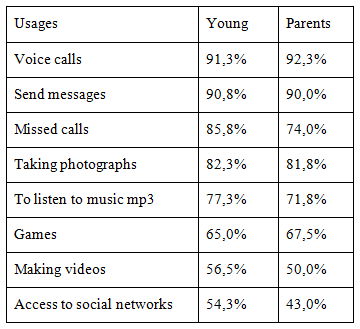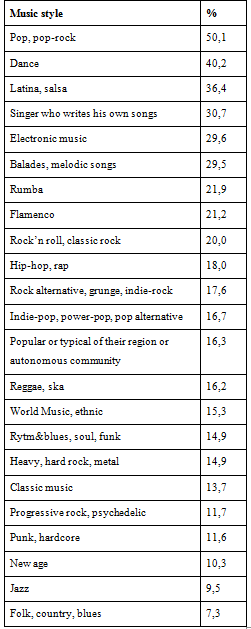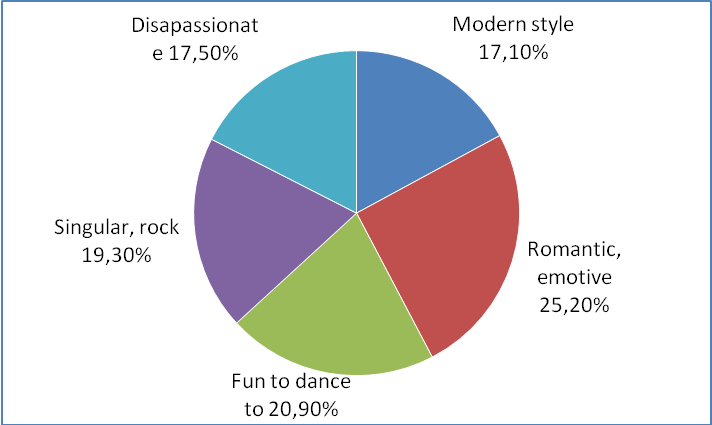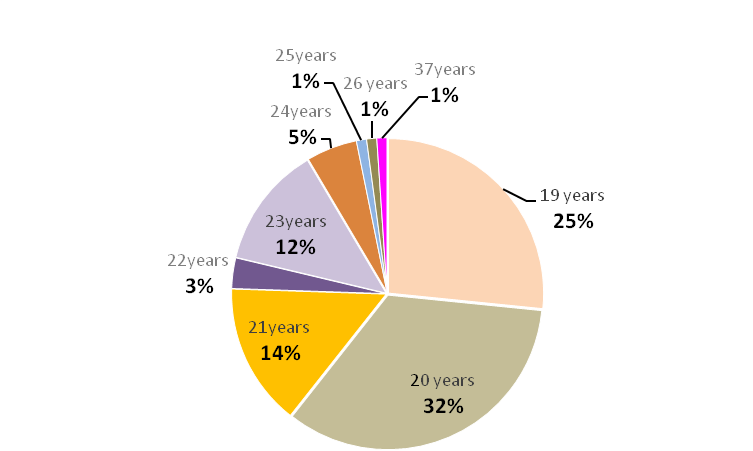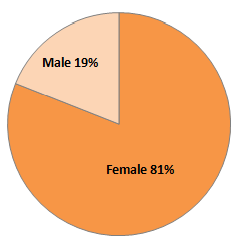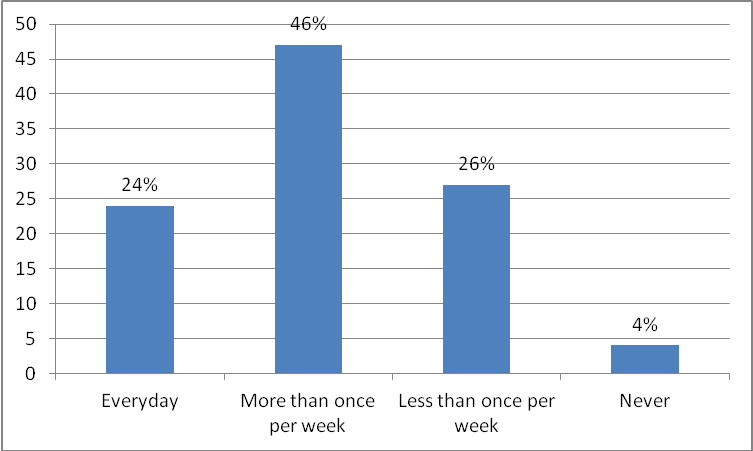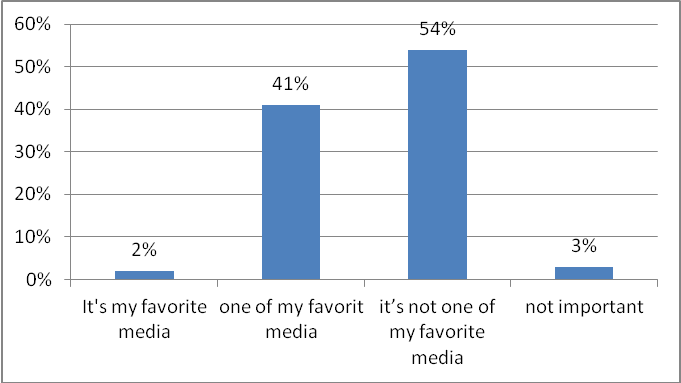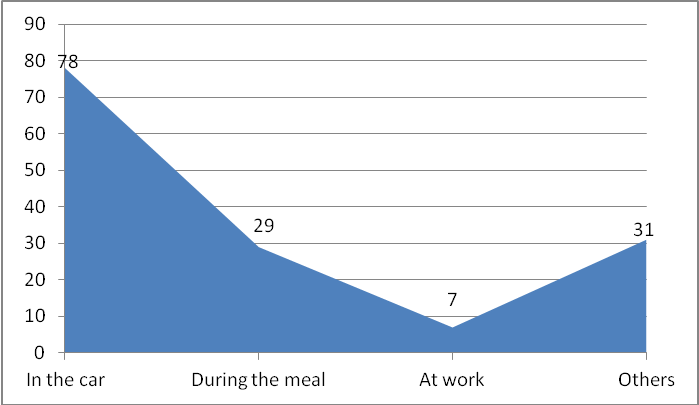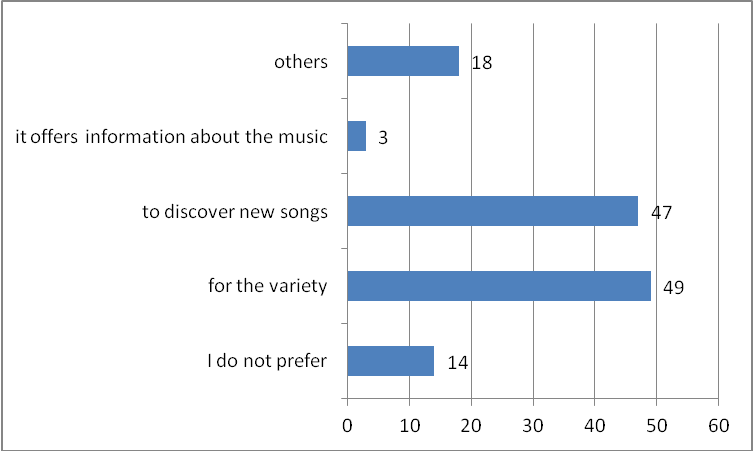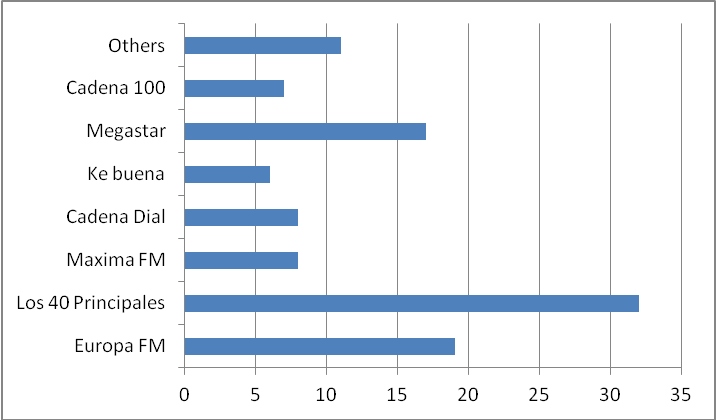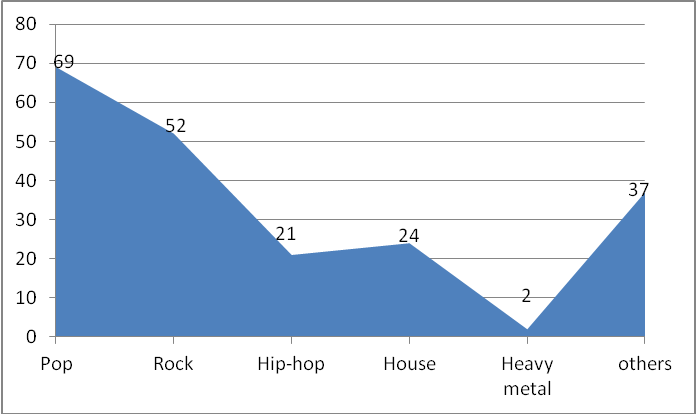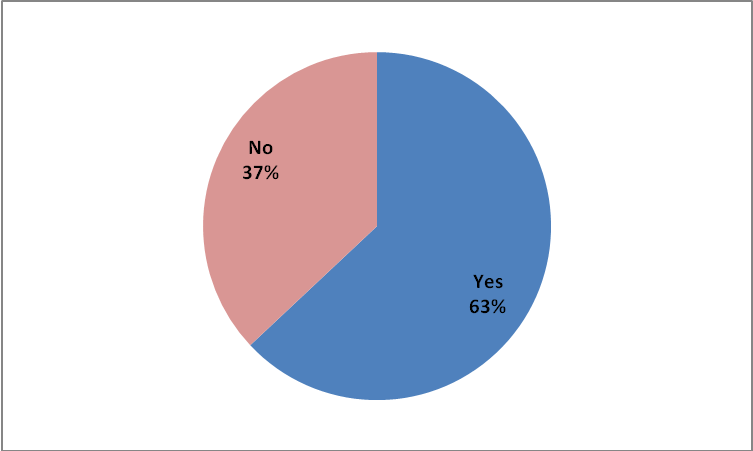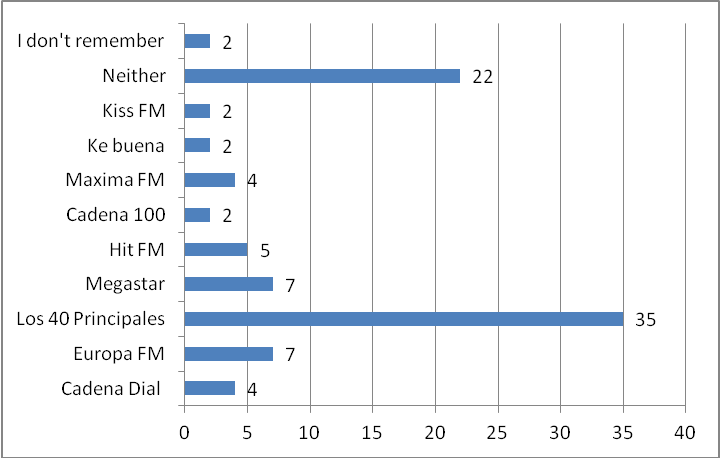MUSIC RADIO: A USES STUDY OF YOUNG AUDIENCES
Йотова А.И.1 , Семова Д.Дж.2
1 ORCID: 0000-0001-7453-6017, Кандидат искусствоведения, доцент, Мадридский университет Комплутенсе, 2 ORCID: 0000-0001-8355-5121, Scopus Author ID: 36678268700, Мадридский университет Комплутенсе
МУЗЫКАЛЬНОЕ РАДИО: ИССЛЕДОВАНИЕ МОЛОДЕЖНОЙ АУДИТОРИИ
Аннотация
Каждый день мы сталкиваемся с музыкой, которая передается различными источниками, один из которых - радио. Данная статья является попыткой рассказать о важности радио для студентов Мадридского университета Комплутенсе. В исследовании был задействован метод анкетирования чтобы выяснить предпочтения студентов, касающихся выбора радио-станции для музыкального прослушивания.
Ключевые слова: музыкальное радио, студенты, музыкальные радиостанции, подростки.
Iotova, Anelia.I.1, Semova, Dimitrina.J.2
1 ORCID: 0000-0001-7453-6017, PhD in Music Education, associate professor, Complutense University of Madrid, 2 ORCID: 0000-0001-8355-5121, Scopus Author ID: 36678268700, Complutense University of Madrid
MUSIC RADIO: A USES STUDY OF YOUNG AUDIENCES
Abstract
We are immersed in the daily hearing of music by different means, one of them: the music radio format. This article tries to clarify its importance for the students of a Spanish Complutense University of Madrid. It is a research, using a questionnaire that investigates the student’s habits and preferences when choosing radio as their musical source.
Keywords: Music Format Radio, Secondary Students, Music Radio Stations, Teenagers.
Introduction
Societies our days are immersed in a reality where their principal sources for both, information and entertainment, come from the media. In this article we focus on how new media, platforms, devices, are changing the way the audience uses now the traditional media. One interesting question will be: having today so many new musical devices, do the teenagers still listen to the radio? What kind of music do they fill their Ipods with? Does the radio influence their music choices? When and where do they consume it? Briefly, is the radio a valuable and decisive source for young people musical choices?
Those are some of the concerns that motivated us to elaborate a questionnaire trying to capture the views of young people in the age between 18 and 30 years. The survey was conducted at the Complutense University of Madrid in November 2015 with 100 students of the Faculties of Education and Information Sciences.
The music radio format derives from the different types of communication within radio, in this case an emotive communication, based on the constant broadcast of music, offering us a message, more ludic than informative, allowing us to listen without having to pay attention and not needing therefore a constant follow-up. That is why it does not transmit conceptual but emotional information: the radio listener asks for a message to the source, mainly musical, that acts as a radio-companion [16].
We differentiate between two different types of radio stations depending on the way the music is processed: monographic musical and music format. The monographic musical is based on different programs organized in blocks and specialized in a specific type of music, live broadcasts of concerts and other relevant musical performances [16]. The monographic musical is represented by classical and popular music on the public radio. The music format is a radio system that has a formal structure, based on repetition according to a particular hourly unit, in order to create a unique musical portrait from the reiteration [16]. Within this model we can find stations like “Los 40 Principales” or “Europa FM”.
Music radio origins date back to a period between 1953 and 1955 which began in Omaha's KOWH (Nebraska), KLFI of Dallas (Texas) and Milwaukee's WOKY stations.
The birth of the music radio format led the transition from traditional radio to modern radio: “the process entailed the break up of the unitary concept of radio”[4:74].
From then on a distinction took place between general radio and specialized radio.
The North American market was the first one to develop this concept of music format, conscious that the invention of television would steal the limelight from the radio, of the types of radio listening (the album or the portable radio, for instance) and of the birth of the youth audience as a specific social group. The Top 40 was interested in offering exclusive contents for specific groups within the population, most of all the youth, contributing some important innovations to programming and promotion of radio companies [16].
The rapid implementation of new systems of dissemination and consumption of music driven by the "digital age" confer a de facto daily use, hence, any prospective on the development of old conventional radio music must be founded on assimilation of the mutations that have permanently altered their identity in the current pop ecosystem and which are specified in the following evidence:
- a) The changes brought about by the Internet cannot be impeded by the radio, since all cultural industries have been affected by the emergence of new media that have brought new cultural consumption habits[6].
- b) Although digital technology in the music market appeared in the early eighties, with the CD release as salvation-standardized support for an industry mired in crisis sales, conversion of the songs could be shared from archives via the Internet, thanks to MP3 format, developed in the second half of the nineties-multiplied exponentially in the distribution of and access to music, and while willful culture established free ownership of the songs and the inevitable reconfiguration of industry [5].
- c) Among these traditional channels, and with physical retail outlets, the most affected is the radio music, which has lost the interest of the younger segment of the audience, which, according to some studies [14], has started looking with disinterest and disaffection at the role of this medium: while maintaining portability and compatibility with other activities like most cherished virtues, radio cannot compete with MP3, iPod or mobile phones when it comes to exchanging files with other users, storing and generating a custom playlist.
- d) To make matters worse, extending the feeling that the musical programming formulae of selections are abused by repetitive use, is hampered by the disc jockey and interrupted by advertising, factors that do not affect the reception of automated music applications.
The appearance of the Smartphone today is another factor that influences the music listening habits of the population especially in the young. A study by the National Institute of Communication Technologies (2011) shows that after using your phone to make voice calls, sending messages and taking photos, the fourth type of usage is to listen to music (Table 1).
Table 1: Smartphone usage by young people and parents
Source: National Institute of Communication Technologies .
The radio is the Spanish people’s most used resource to listen music as stated by the
“Survey of Habits and Cultural Practices in Spain 2010-2011” (Ministry of Education, 2011). This is an official statistic study included in the Statistical National Plan, sampling 16,000 people from 14 years old and more executed by the INE and focused on studying the main indicators of habits and cultural practices of the Spanish people.
This statistic considers different types of cultural activities, from book reading and visits to art galleries to audio-visual resources, like cinema or radio. Based on a sample of 1900 young men and women between 15 and 24 years of age in all Spanish territory are shown the most popular musical styles of the young Spanish (Table 2).
Table 2: Musical preferences that young people valued in relation to their music tastes
Source: Megías and Rodríguez
Figure 1: Quantitative representation of the different styles
Source: based on Megías and Rodriguez (2003:191).
The cultural proximity seems important as well as comprehensive elements of music, i.e all questions that related to the ability of performing music from empathy and connection with local culture.
According to Legorburu [10] there are five key features in radio: immediate, fleeting, stimulating, inability to choose and time limited. Perhaps the most important radio feature among the five mentioned is the “stimulating nature”, because it stimulates the listeners’ imagination as well as their creativity. As Lull writes [12] radio fosters this human facet, since the lack of visual stimuli produces a mental enactment of the colors, people and events that the wireless message transmits, and that is strengthened by means of the channeling of the message by agents such as voice, a language closer to the people, and with music, a source of emotions and thoughts.
According to Pérez-Latre [17] there is a very close cohesion among young people, musical radio and the consumption of popular music, which constitutes the largest audience target in this format. And that is not casual, studies like “Ocio en los nuevos medios de comunicación” [2] or “A German Study on the Use of radio in Teenagers” [1] confirm it, besides revealing that musical content programs are most preferred by teenagers compared to other types of radio programs, which has created a competitiveness among stations based on the content that they broadcast in relation to the age of their listeners.
Moreover, this aspect has been enhanced with the origin of the so-called "Smartphones", which allows users to use it both as a radio or MP3 device. Advances in technology have also allowed the listener to hear the radio through the Internet, live or accessing the recordings of the programs. We know that in Spain nearly 20% of young people access the radio stations via Internet [15], and this let us think that this feature could have heavily influenced the radio music format.
Musical promotion through radio
Record companies spend large amounts of money and resources to promote their products, both in the media and in the live concerts. Not only do they promote them directly, on the radio, but they also employ innovative formulas like music contests or awards that make people get interested in by the reiteration. For instance, we have the so-called “summer’s Song”, which is described as “that song that causes more media impact during the summer months” [19]. Those are very catchy songs, whose chorus is constantly repeated, very danceable and can be heard both on the radio and other media as in trendy local bars or other environments, which causes people to become familiar with them by the reiteration.
Cremades [3] mentions that “the stations with musical programming that focus on the diffusion of hits and music record sales, Spanish and foreign, are the most listened to by the young people”. The most listened stations according to this author are in this order: Los 40 Principales, Cadena Dial, Cadena 100, Europa FM and Kiss FM.
To establish its schedule, 40 Principales, for example, creates every week a list where the 40 most successful songs in the market are placed, ordering them from the 40th to the 1st position and repeating them constantly. The same happens in the other music format stations cited above, although in each one the order and the number of songs vary. Information about the artists, tours, concerts and recordings is also provided. Within Los 40 Principales’s programming, the music styles that are broadcasted on this station are mostly Pop, Rock and Dance, both in Spanish and other languages, especially English. This station has been the undisputed audience leader and example among all music radio stations in recent years.
According to the research, the most popular music styles among young Spanish are pop, rock and dance. In general the term rock refers to some styles of pop music developed since the fifties from Rock & Roll. Normally, it is vocal music accompanied by guitar, bass, keyboards and drums.
Since its start, the Rock was born as an identifier of the younger generation to adults and to other sociomusical groups.
Meanwhile, pop is one of these subgenres emerged in Anglo-Saxon from the fifties and, at the moment, an important phenomenon of mass communication released worldwide. It is characterized by a simple structure, melodic and catchy, with a standard verse-chorus-verse structure in which the voice plays a major role and percussion remains with very regular patterns.
Rock is the music style that has had the most relationship with technological advances:
Since its beginning, Rock has been linked to the electronic amplification and later it incorporated purely electronic instruments.
When these styles were born, sound recording was already a routine and has not been incorporated later. Hence, their music the disc is seen as a logical product of their work, something that doesn’t happen in other styles.
The dissemination of this music is based on means of communication totally limited to technology (such as radio, television, Internet, mobile phones, etc.)
From the moment in which music can be understood as a consumer product at is fully subjected to laws of industry, so that its maintenance and evolution are entirely dependent on these laws.
Dance style appears as the evolution of other styles like Pop, House, or Techno. It is the most commercial variant of electronic music. Dance is composed music specifically to accompany the dance and it usually has synthetic sounds, marked rhythms, repetitive and easily danceable. The lyrics are catchy and the structure is like that of Pop: verse - chorus - verse.
Objectives of the study
Our study pursues the following objectives:
To detect if our target group listen to music format radio and how often they do it.
To try to evaluate the importance of the radio to the young people aged 19-23 through a survey of university students.
To collect information about the students’ favorite radio stations and their favorite music styles.
Methodology
The paradigm is interpretative according to Llamas [11] who defines it as the one whose aim is the understanding of the facts or situations, analyzing the behaviors of the people we are going to investigate.
The study employed a questionnaire as a data collection instrument. According to García [8] it is an evaluation technique which can take on both the quantitative and qualitative aspects.
The research was carried out between 19th and 23rd November 2015. The questionnaire we used had both, open answers (trying to recognize the opinions of the participants) and 7 closed answers, 3 of them multiple choice and 4 of them were of simple choice.
Analysis of the results:
Participants
Our survey participants are one hundred students from the Complutense University of Madrid of the age of, 19 and 23 years, mostly, divided in two groups: fifty of them are from the career of Education and the other fifty- from the field of the Communication Sciences.
Figure 2: Age range
Source: own survey.
Most of the participants are female, 81% (Figure 3).
Figure 3: Female/male participants proportion:
Source: own survey.
From questionnaire’s first question block, we find general information about the students’ radio listening habits. This data reveals that almost all students listen to the music format radio, except 4% that answers negatively (see Diagram 3).
Chart 1: Response to the question Do you usually listen to music on the radio?
Source: own results
The 24 % of the total sais they listen to the music in the radio every day; the 46% more than once per week. A quarter part do it occasionally. Only a 4% admits not to listen to music on the radio.
To the question “Is the radio one of your favorite media to listen to music?”, only the 2 per cent of the students choose the radio as their preferred media, however, the 41% consider it as one of the most preferred (Chart 2). Taking into account that there are many other sources such as the Internet, CDs, DVDs, TV and the MP3s, we think that that is a significant percentage that points out to the great importance of the music format radio for them.
Chart 2: Response to the question Is the radio one of your favorite sources of music?
Source: own results
The answers to the question, "In which moments do you listen to music on the radio?", reveals that most of the participants effects it in the car. A significant percentage makes it during the lunch or dinner. "At work" was the answer of the 7% of the participants. All this confirms that listening to music radio format occurs at different times.
Chart 3: Response to the question In which moments do you listen to music on the radio? (Numbers of replies)
Source: own results
One of the open question helped us to delve into the reasons why the students prefer listening to music on the radio instead of other sources. Through the question “Why do you prefer listening to music in the radio instead of other musical resources?”, we could check that for the most of the youngsters (96 responses), radio is the most suitable resource because it offers varied music and also, because it is a source for knowing new songs (Chart 4). A small part appreciates that it provides them with information about music market news and novelties. An assertion likes “Because it informs you about music news” or “Because I find new tunes” confirms it.
Chart 4: “Why do you prefer listening to music in the radio instead of other musical resources?” (Numbers of replies)
Source: own results.
Other interviewees point to reasons like the comfort of being able to carry it anywhere or the availability of different stations: the surprise factor, come to hear songs that I had almost forgotten; my Mp3 comes a time that bore you; because my mobile has always the same and the radio is more varied.
The next question was about the favorite radio stations. The multiple responses shows that Los 40 Principales occupies a privileged place. Europa FM and Máxima FM stations are also among the students’ favorite choices. We have here also the Cadena 100, Megastar, Cadena Dial, Kiss FM, Rock FM, Ke buena. In “others” the students mentioned: Rock & Gol (5), Radiole(4), M80(3) and Hit Fm (3) (Chart 5).
Chart 5: The most listened music radio stations: (numbers of replies)
Source: own results.
Using the a second open question, we delved into the reasons of the previous choices. Most of the youngsters admit they like, for example, the programming of Los 40 Principales and the tunes it broadcasts. Other reasons, in general, are: “because it broadcasts today's music”(3); “because the recent is there” or “because the best known one are there”. Some students admit they listen it because of their habit. Other people stay that they constantly change stations looking for their favorite: “I change station depending on the songs they broadcast”.
Fans of Europa FM prefer it because they identify themselves with the songs they consider today's music: " I know almost all the songs and I love it because I can sing in the car”. The Máxima FM is preferred by 38 people because of its diverse, current offerings and its rhythmic character: “because of variety”; “because it has all the music that inspires me and puts me in a good mood”; “fast pace”; “today's music”. Participants, who choose Cadena 100, Cadena Dial, identify with the style of the station combining the classical with the new. Also, "because the songs are in Spanish and I can sing."
It was interesting to detect that there are youngsters who prefer Kiss FM (4) or M80 (1) because they offer songs from the 80s and 90s They regard these songs as "classic".
According to the Organization for the Media Researches (AIMC) survey results carried out, between February and November 2011, the Spanish youth’s favorite styles are: pop, rock, hip-hop, house and heavy metal. We offered the same genres in our multiple choice question “What kinds of music do you usually listen to on the radio?” including the “others” option to collect all the variety of answers. The data reveals that pop, rock, hip-hop and house are among their favorite music styles. In the following diagram we can check the relation between answers and notice that two of them are chosen by more than a half: pop and rock. The Heavy, as a style, is apparently not among the favorites of our respondents. In the “other styles” section, the students marked the following ones: reggaeton (7), reggae (2) Indie (4), flamenco (6), rap (2), latin music (5), jazz (1) and classic (1) (Chart 6).
Chart 6: What kinds of music do you usually listen to on the radio? (Numbers of replies)
Source: own results
To find out more about the importance of radio music formats, we addressed the following question: "Among your favorite songs, are there some you've discovered on the radio?" The answers reveal that more than a half of the favorite songs of our students have been known in this medium indicating that the radio definitely has a significant importance (Chart 7).
Chart 7: Response to the question: "Among your favorite songs, are there some you have discovered on the radio?"
Source: own results
Through the last question, you were able to detect that the most listened station is also in our case, it is Los 40 Principales. Also important is the number of people who answer they do not have known their favorite songs on the radio (22) (Chart 8).
Chart 8: Do you remember on what radio station you knew your favorite song? (Numbers of replies)
Source: own results
Conclusions
According to the aims expressed in this study, the procedures used and the result obtained, we arrived to some very interesting conclusions. We detected that almost all of the students listen to music format radio and more than the 25% do it regularly.
Throughout the present research we could check the significant interest shown by young people about music, which consists on its constant presence in most of the situations.
The students give great importance to radio as a music source because it offers the students’ favorite music styles, information about news and the latest in the music world.
We could verify that the respondents favorite station is Los 40 Principales, followed by Europa FM and Maxima FM. The majority find Los 40 station as the most attractive because of its programming, based on current music, constantly broadcasting the latest hits.
About the student’s favorite styles, we could verify that the emphasis is on POP, closely followed by ROCK, HIP HOP and house.
It is clear that students need and wish to be at the latest musical style and keep an eye on the novelties. This must influence their music taste.
As a consequence of being a cultural product, instead of an art one, it is treated as a product in the market. The music industry is the one that guides the most listened styles, for which it employs all kinds of campaigns supported by the mass media. One of the most appreciated media that the companies choose to promote it is radio music format, that is responsible for repeated emission and dissemination it of the hits among the youth.
This is how the success of a group or singer is not always based on its quality, but on the circumstances in which it has appeared, how it has managed within those circumstances and, most of all, by the advertising campaign that has accompanied it.
We are thinking about doing another research as a continuation of this theme with the aim of finding out how strong this influence is on them and the factors that define it. Besides, as music teachers, we pose the question: How can we help students to get criteria and guide them to choose their music? Can we expand their habits and music tastes using mechanisms similar to music format radio stations?
References
- Boehnke, K., Munich, T & Hoffmann, D. Development through media use? A German study on the use of radio in adolescence. //International Journal of Behavioral Development . - 2002. Vol.26 (3), P.193-201
- Borafull, I. Ocio en los nuevos medios de comunicación.//Revista de Estudios de Juventud. - 2005. Vol.68, P.116-127.
- Cremades Andreu, R. Adolescentes y música: Consumo musical y educación informal. Dúrcal, Granada: K&L, 2006.
- Faus Belau, A. La era audiovisual. Historia de los primeros cien años de la radio y la televisión. Barcelona: EIUNSA, 1995.
- Fouce Rodríguez, H. Prácticas emergentes y nuevas tecnologías: El caso de la música digital en España//Documento de trabajo 02-2009, Fundación Alternativas, España – 2009.
- Franquet, R.; Ribes, X.; Soto, T.; Fernandez Quijada, D. La información en la TDT interactiva: una oferta incipiente para una prácticas periodísticas en transformación, Barcelona: Trípodos – 2008. Vol. 23, P.15-29.
- García-González, A. (2011): “La radio musical frente a internet. Análisis de fuentes de internet para la escucha de música“// Alcudia, M. Y Ruiz, S. La radio musical: géneros y formatos en constante evolución. Cuadernos de C. Audiovisual. Madrid: CEU. – 2011. Vol. 3. P.22-34
- García, T. El cuestionario como instrumento de investigación/evaluación. URL: http://www.univsantana.com/sociologia/El_Cuestionario.pdf 30.12.2015
- Haye, R. M. Hacia una nueva radio. Buenos Aires: Paidós, 1995. 4 7 35 7 5 2 4 2 2 22 2 0 10 20 30 40 Cadena Dial Europa FM Los 40 Principales Megastar Hit FM Cadena 100 Maxima FM Ke buena Kiss FM Neither I don't remember Международный научно-исследовательский журнал ▪ № 2 (44) ▪ Часть 1 ▪Февраль 80
- Legorburu, J. M. Utilidad y eficacia de la comunicación radiofónica en el proceso educativo. Madrid: Tesis doctoral inédita, 2001.
- Llamas, J., Galán, M.A. & Velásquez, B. Introducción a la investigación en educación. Madrid: Universidad Nacional de Educación a Distancia, 2001.
- Lull, J. Medios, Comunicación, Cultura. Una Aproximación Global. Buenos Aires: Amorrortu, 1997.
- Martí, J.M. et al. La crisi del consum radiofònic juvenil a Catalunya// En:Quaderns del CAC – 2010. N.º 34, vol. XIII (1) p. 67-77.
- Martín-López, B., García-Llorente, M., Gómez-Baggethun, E. y Montes,C. Evaluación de los servicios de los ecosistemas del sistema socio-ecológico de Doñana//Forum de Sostenibilidad – 2010. Vol. 4. P. 91-111.
- Megías,I. and Rodríguez, E. Jóvenes entre sonidos: Hábitos, gustos y referentes musicales. Edición Injuve – FAD, 2003.
- Moreno, I. Didáctica de la radio en el aula: posibilidades para comunicar de forma creativa. Madrid: Universidad Complutense de Madrid: Tesis doctoral, 1999.
- Pérez-Latre, F. J. Bringué, X. Comunicación efectiva en circunstancias difíciles: el público entre 14 y 19// Revista de Estudios de Juventud – 2005. Vol. 68. P. 53-59.
- Puente, E. Preferencias musicales de los jóvenes fuera de las aulas// Eufonía – 1996. Vol. 5 P.81-94
- Sevik, G. What Price, Fame? //Popular Music and Society – 2001. Vol. 25(3-4). P. 85-90.

